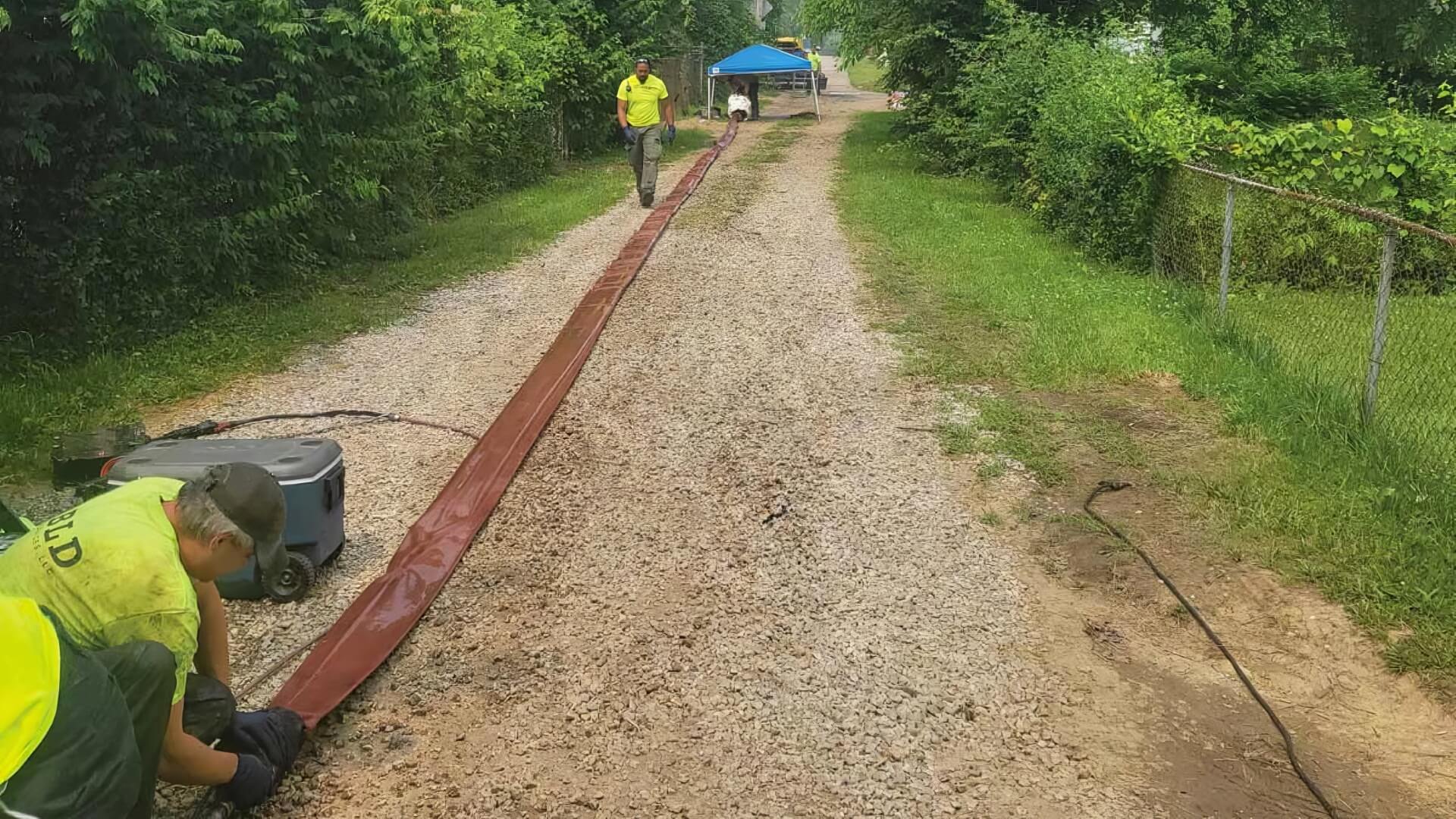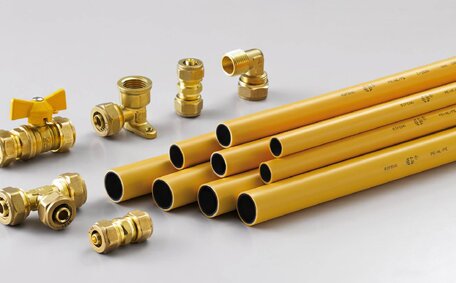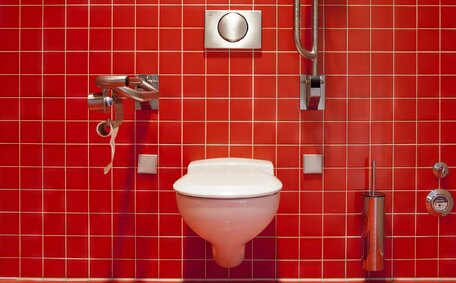Check If Your Hot Water Is Completely Out or Just Low
Begin by testing multiple taps in different areas of your home to determine if the absence of hot water is a general problem or confined to specific locations.
Begin with a tap distant from your water heater, like an upstairs tap, to test for hot water. If it’s cold, also check taps nearer to the water heater, such as those in the laundry or bathroom.
If all hot water taps have no hot water at all, then you likely have a system-wide issue affecting water flow or heating. This may suggest issues like blocked drains, a faulty valve or a small leak rather than a complete water heater failure.
However, if some taps have hot water and others don’t, your problem is probably isolated.
Quickly evaluating the lack of hot water helps pinpoint the severity and potential causes, aiding in deciding whether to seek immediate professional assistance or not.
Identify if You Have an Electric or Gas Hot Water System
Determining whether you have a gas, electric, or gas-electric hybrid hot water system is crucial as it influences the troubleshooting process and the issues you might encounter.
Signs you have an electric hot water system include an electrical cord coming from the tank, a thermostat on the outside with buttons to adjust temperature, a circuit breaker inside the main electrical panel, and heating elements inside the tank.
Signs of a gas system are a gas line entering the unit, a pilot light, and in some cases a flame coming from the burner when heating up. Gas systems may have a thermocouple and thermostat as well.
When the type of your water heater is unclear, examining nearby gas pipes or electrical connections can provide clarity; consulting the user manual is also advisable. This knowledge is key to addressing no hot water issues efficiently and securely.
Check the Power and Gas Supply
After confirming the lack of hot water, check that your electric system has power, and if you have a gas heater, verify that there’s a consistent gas supply.
For electric water heaters, check whether the electrical cord is damaged or has come loose. Ensure it’s securely plugged into a working GPO. Also, check your household circuit breaker connected to the water heater and reset it if tripped.
For gas systems, inspect the external gas line for damage or leaks. To assure steady gas flow, make sure your manual gas valve is fully open. Check if the pilot light is still lit - relight it if needed per the manufacturer instructions.
Since gas for water heating contributes to a significant portion of home energy use in Australia, ensuring a functional gas supply for gas heaters is essential. Similarly, for electric systems, assessing power supply issues can reveal whether external services or internal water flow disruptions are at fault.
Inspect the External Components
Perform a swift visual examination of your hot water system’s outer parts for obvious signs of trouble.
Scout for any patent signs of water coming from damage like cracks or leaks in the water heater exterior and connected piping. Ensure valves linked to your hot water system are open, securing an uninterrupted water supply. Ensure electrical wiring or gas lines aren’t obstructed or hazardous.
Inspect nearby plumbing fixtures for leaks or decay. Even running toilets can stealthily deplete your hot water supply.
Regular inspections of your water heater’s external parts can help thwart future problems and detect malfunctions early on.
Troubleshoot Issues With Electric Hot Water Systems
Check the Circuit Breaker
One common issue for electric hot water systems is a tripped circuit breaker. Locate the breaker connected to the water heater in your home’s main circuit panel.
In case of a tripped circuit, flip the breaker back on to reestablish power.
Inspect the Heating Elements
Should resetting the breaker not revive hot water, it may be necessary to replace malfunctioning internal heating elements.
Before proceeding, turn off your water heater’s power at the circuit breaker. Visually inspect each element for cracks or corrosion. Use a multimeter to check element continuity. Replace faulty ones with identical elements.
Reset the Circuit Breaker
Resetting a tripped circuit breaker is a crucial troubleshooting method for your hot water system. Here are the steps for a safe reset:
- Locate the circuit breaker connected to the water heater in your home’s main circuit panel. It should be clearly labelled.
- Flip the breaker all the way to OFF first.
- Then flip it back ON fully to the reset position.
- If the circuit trips immediately again, this could indicate an electrical fault with the unit’s wiring or heating elements. Caution is advised, and it’s recommended to promptly contact a licensed electrician for inspection.
Resetting the breaker might reinstate both power and hot water if the trip was accidental. Yet, if problems continue, do not try to circumvent electrical safety measures. Contact our skilled team at [Business Name] on [Business Phone] for dependable troubleshooting and repairs.
Check the Heating Element
Inside the water heater tank, the heating element in an electric hot water system takes up the task of warming the water. It’s typically made of metal and may consist of one or two rods inside the tank controlled by a thermostat. As water coming out of the tap encounters the powered element, it rapidly heats to roughly 40-60°C, contingent on your thermostat setting.
To check if the heating element is working correctly:
- Switch off power to your hot water heater at the circuit breaker
- Remove the access panel and locate the element(s)
- Visually inspect for any cracks, corrosion or damage
- Use a multimeter to check for continuity confirming intact wiring
- Should it be defective, fit an identical heating element within the heater tank
Should the heating element be in working order, the thermostat could be at fault. While it’s common for heating elements to fail, they are relatively inexpensive and simple to replace yourself. If you have any doubts, our team is ready to inspect and ascertain the root of the problem.
Inspect for Leaks
Inspecting for leaks is an important troubleshooting step when you have no hot water. Start by visually checking the hot water unit and connected pipes for signs of water dripping or pooling under the system. Also check areas near plumbing fixtures fed by the hot water system.
Small leaks, evident through slow drips or puddles, can result in heated water loss and gradual system drainage.
Larger leaks can cause more severe pressure drops and flow issues. Fix any leaky fixtures or joints. Replace corroded pipes or valves.
Also check the water heater’s temperature and pressure relief valve by lifting the lever. Water draining may mean it needs replacing. Consider installing a leak detection system for monitoring.
Unaddressed leaks can worsen, potentially causing significant damage to your property. Early intervention also reduces wasted water and energy. If the source of the leak eludes you, or you’re uncertain about the repair needs, contact your local team for a thorough inspection and repairs.
Troubleshoot Issues With Gas Hot Water Systems
Check the Pilot Light
For those using a gas water heater, make sure the pilot light is active. Find the small flame in the unit and, if extinguished, reignite it according to the manufacturer’s guidelines. Additionally, confirm that all manual gas valves are fully open for unobstructed fuel delivery.
Inspect the Thermocouple
The thermocouple is a safety device that cuts gas flow if the pilot light goes out. Re-lighting the pilot without addressing a faulty thermocouple will cause continuous relighting issues.
Check for damage or corrosion. Use a multimeter to test for continuity. If faulty, replace it with an identical model.
Should the pilot refuse to stay lit after replacing the thermocouple, it suggests the gas control valve or thermostat may not be working properly. Call a professional for inspection and repairs to avoid a dangerous gas leak.
Relight the Pilot Light
If your gas hot water system has no hot water, one common issue is the pilot light going out. Here is how to safely relight it:
- Locate the pilot light assembly inside the main burner compartment
- Switch off hot water supply, then turn the gas control knob to "Pilot"
- Push down the gas control knob fully and hold to start gas flow while igniting the pilot with the push button igniter
- Hold the knob down for 30 seconds after lighting to allow the thermocouple to heat up
- Release the knob and ensure the pilot remains lit. If not, repeat steps 2-4.
- Once lit, turn the gas knob to "On" restoring hot water heating.
If the pilot won’t stay lit, shut off gas supply and call a professional immediately. For ongoing hot water issues call our team at [Business Name] on [Business Phone].
Similarly, for any noticeable gas odours, prioritise safety and promptly seek professional help.
Replace the Thermocouple
The thermocouple is a safety device in gas hot water systems. It cuts off gas flow to the pilot light and burner if the pilot goes out. This prevents dangerous gas leaks.
To check if your thermocouple is faulty:
- Inspect it visually for damage, corrosion or cracks
- Use a multimeter to test for continuity confirming intact wiring
- Compare readings to manufacturer specifications
Upon finding a faulty thermocouple, shut off the gas, replace with a matching model, and after installation, relight the pilot light to test the new part’s functionality.
However, if the pilot won’t stay lit after thermocouple replacement, issues with the gas valve or thermostat should be suspected. Should you require aid in inspecting or replacing thermocouples, give us a ring at [Business Name], with our seasoned team ready to help on [Business Phone].
Common Causes and Quick Fixes for No Hot Water
There are several common causes for having no hot water in your home that often have quick fixes to get your hot water running again:
- Tripped circuit breaker - Just reset it to ensure your electric system provides enough hot water.
- Pilot light is out - Relight the pilot on a gas hot water system by following the manufacturer’s instructions.
- Faulty heating element - Replace damaged electric heating elements in the hot water tank.
- Sediment buildup - Drain a few litres from the tank bottom to flush sediment clogging pipes or valves.
- Faulty thermostat - Replace the thermostat controlling your hot water system.
While these actions might solve the immediate issue, ongoing or intermittent problems call for a detailed maintenance check by a professional.
Our licensed plumbers are equipped to examine your hot water unit and plumbing, diagnose issues, and perform necessary repairs or part replacements. Additionally, we offer preventative maintenance services to circumvent future complications.
Don’t hesitate to contact our friendly team at [Business Name] on [Business Phone] for prompt, reliable hot water repairs and service.
When to Call a Professional Plumber or Electrician
Enlist a professional plumber or electrician when hot water problems are hazardous, complex, or persistent. Signs you need to contact the experts include:
- Identified gas leaks or odours
- Faults with the gas valve, piping or supply
- Electrical issues like damaged wiring
- Major leaks from water heater or pipes
- Complex repairs beyond DIY skills
- Reoccurring pilot light or heating element failures
- Old systems that may need upgrades or a new hot water system installation
As per the Residential Tenancies Act, tenants must notify the landlord/real estate agent immediately for emergency repairs like no hot water. Failure to provide hot water breaches minimum rental standards.
Our team of licenced plumbers at [Business Name] have extensive experience troubleshooting all makes and models of hot water systems. We can quickly diagnose issues and undertake necessary repairs or replacements. Contact us on [Business Phone] for prompt, reliable hot water solutions.
Preventative Maintenance for Your Hot Water System
Regular preventative maintenance of your hot water system can forestall typical issues that cause a lack of hot water.
You can undertake straightforward maintenance tasks such as:
- Draining 1-2 litres from the tank bottom every 6 months to flush sediment
- Visually inspecting pipes, valves and fittings for leaks annually
- Testing temperature and pressure relief valves to ensure proper operation
- Checking anode rods in electric water heaters every 2-4 years
To address more in-depth maintenance requirements, our licensed plumbers at [Business Name], operating in the Hills District, provide top-notch service customised to the specifics of your system.
We can undertake essential tasks like flush cleaning, part replacements, leak detection, roof integrity checks and more. Preventative maintenance from our experienced team keeps your hot water system running reliably while extending its lifespan.
Contact us on [Business Phone] to ask about our maintenance plans or to schedule your next hot water system service.






